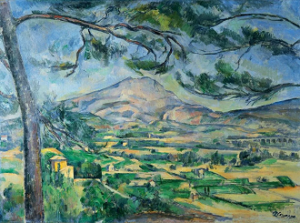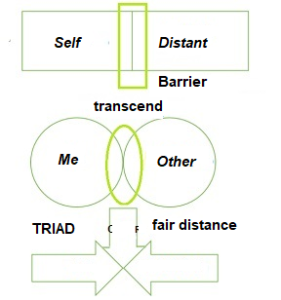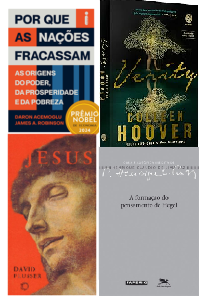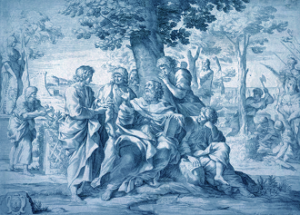
Arquivo para a ‘Método e Verdade Científica’ Categoria
For a true asceticism
Peter Sloterdijk, despite being an agnostic, points out a “spiritual” defect in today’s society: it is a “society of exercises” that do not lead to a true inner “ascent”; it is a society of agitation, looking for “efficiency”, the “society of tiredness”.
points out a “spiritual” defect in today’s society: it is a “society of exercises” that do not lead to a true inner “ascent”; it is a society of agitation, looking for “efficiency”, the “society of tiredness”.
The lack of time for meditation, for exercising the mind and soul, is leading to “brainrot”, the word of the moment according to Oxford University, which has included it in the dictionary, meaning rotten brain. It’s not just a question of consuming bad information, ignorance and the lack of exercise in a “contemplative life” as Byung Chul Han calls for creates a space in the mind for this type of thinking to grow.
We create a culture that isn’t even counter-culture in the sense of civilizational evolution, it’s just something rotten, we bombard our brains with fragments of thoughts, spiritual fragments without them completing each other and forming within us a true spiritual asceticism.
It’s empty activism, and to fill it we need more narcotics and food to fill the body’s emptiness while the mind remains empty, this same emptiness that could serve to create a “contemplative life” that would support asceticism and a balance in the virtuous circle.
Chul Han also recalls painting, quoting the work of the Frenchman Paul Cézanne: “Painting means nothing more than ‘letting go of the friendship of all these things in the open air’” (Han, 2023, p. 49).
It’s not just media culture that does this, it’s the absence of structural values of virtue and morality.
The loss of culture (or what remains of it according to Antoine Daniels) is this inability to see beauty and truth.
Of course, true asceticism, in the spiritual sense, cannot fail to encounter the divine, and as for useless “exercises” to take a “bath in spirituality” only to come out empty and without encountering being, says Han: “in the deep layers of being, they are suspended” (Han, 2023, p. 49).
It’s not just media culture that does this, it’s the absence of structural values of virtue and morality.
“The landscape of inactivity,” writes Byung Chul-Han about Cézanne, ‘breaks with nature made human and restores a non-humanized order of things in which they can meet’ (Han, p. 50).
Still quoting Cézanne: “Ah! Landscape has never been painted. The human being must not be there, but must have found himself entirely in the landscape” (p. 51), the ‘noisy self’ must be ‘silenced’.
How many people participate in the “exercise society” just to laugh and get emotional, without having “entered the landscape”, without the slightest contact with the divine, needing noise, food and drink to fill the emptiness they have in their souls and not in their stomachs?
Only an exercise in true asceticism can lead us to Love, the synthesis of the virtues, but without forgetting them: it introduces us to balance, courage, listening and sincere social relationships.
HAN, B. C. Vita Contemplativa (Vita Contemplativa: or on inactivity). Trad. By Lucas Machado. Brazil. Petrópolis, RJ: Vozes, 2023.
Voices in the desert
In times of crisis there are a small number of  voices that see beyond the clashing forces, neither the apocalyptic nor the integrated (as Umberto Eco would say), but those who understand the panorama and the roots of the temporal crises and go beyond the temporal, they see the divine civilization.
voices that see beyond the clashing forces, neither the apocalyptic nor the integrated (as Umberto Eco would say), but those who understand the panorama and the roots of the temporal crises and go beyond the temporal, they see the divine civilization.
Dostoevsky’s figure of the idiot is one of these figures who saw a crisis in the society of the time, a decadent feudalism in Russia, and imagined a society with ethics and morals, not just a structural change, but a change in the way of seeing society and the Other.
The integrated people who live under the dominion of ideas that have already been proven to be outdated, almost all of which come from European idealism, which imagined an eternal peace (Kant) without understanding the basis of the conflicts, which was a vision of a warlike and intercessory state in everyday life.
David Flusser’s analysis of the social situation at the time of Jesus in the first century of the Christian era is also similar. His book Jesus deals with the social, political and religious conflicts of the time, and as a Jew he paints a visionary picture of Jesus at the time.
A true prophecy was coming true, and the prophet Isaiah spoke well before that time about a prophet who would come (the last and the greatest, therefore true) according to Mark (Mk 1:2-3): “Behold, I am sending my messenger ahead of you to prepare your way. This is the voice of him who cries out in the wilderness: ‘Prepare the way of the Lord, make his highways straight! “.
John the Baptist was the “idiot” of his time, few understood clearly what he was saying about the coming of the Messiah, some wanted to interpret him politically as a warrior-savior and others as a madman who lived in the desert feeding on honey and locusts.
The religious and apocalyptic people of our time are incapable of understanding him and that’s why they are Pharisees and false prophets. In the midst of a crisis, they announce riches and abundance that are unattainable for the simple people who are exploited by them.
Saviors of the homeland are different from saviors who prepare a divine path for a post-war, post-crisis, post-religious warmongering future and from “partners” (in reference to Paul Ricoeur mentioned in previous posts), we need a worldview that clearly sees the cardinal virtues and does not separate justice and wisdom from them).
The Other and narcissism
The brain rot has a face that is not easily detected: narcissism. The Greek myth that gave rise to the name of this pathology is that Narcissus thought he was so beautiful that he spurned several suitors until he fell in love with his own image and died of hunger and thirst on the banks of a river that reflected his own image (in the photo, a drawing found in Pompeii).
narcissism. The Greek myth that gave rise to the name of this pathology is that Narcissus thought he was so beautiful that he spurned several suitors until he fell in love with his own image and died of hunger and thirst on the banks of a river that reflected his own image (in the photo, a drawing found in Pompeii).
By sticking to our own convictions, values and customs, we develop narratives that justify our worldview, our position or even despise others that may seem reasonable, but I prefer to follow my own guidelines.
The Other is thus a negativity for the narcissist, in philosophy it’s not just people or a distinct entity in relation to oneself, it can also be the diversity of experiences, cultures, beliefs and habits, in short everything that synthesizes a new worldview, different from Narcissus.
Thus, media trends that emphasize a certain behaviour and way of thinking are a dangerous instrument of brain rot, creating narratives and truths that seem true, but in general they abuse marketing, the use of sounds and images that trap the follower.
At the root of everything is idealism and the idea of “models” to be followed, but at a more advanced stage with the use of media, fixing ideas and concepts depends on a certain marketing skill and the use of reliable, sometimes even intelligent, things, the idea of simplicity and the difficulty of understanding the complex is what makes this methodology possible.
The Other, in a nutshell, is everything that is not a mirror, everything that is far from what we have as a model, whether it’s my worldview, my beliefs or, more complicatedly, different political positions.
The fact that a new methodology is needed, such as the hermeneutic circle that proposes the fusion of horizons before “dialog”, a new epistemology that escapes the bipolarity of Being is and not Being is not, creating a third included, like the one already pointed out in modern quantum physics.
So it’s not necessarily a convergent dialog, but one that starts from a common point, there is an initial fusion of horizons, in other words, it starts from a certain initial “convergence”.
Considering the Other is essential in order to escape bipolarization and the common sense of simplistic explanations for complex issues. Here too, a certain simplicity may be necessary: the Other, although not a mirror, has something in common, at the very least the fact that we share the same historical moment, the same era and the same desire for peace.
Love: the neighbor and the partner
One of the hardest chapters in the fall of civilization is the transformation of the concept of love. There are even pathologies that live off the cancellation of this relationship, but the basis is the transformation into interest, where interests matter more than any kind of empathy or affection.
civilization is the transformation of the concept of love. There are even pathologies that live off the cancellation of this relationship, but the basis is the transformation into interest, where interests matter more than any kind of empathy or affection.
Paul Ricoeur was the philosopher who directly addressed this issue in his book “History and Truth”, which I would say is a complement to Hans-Georg Gadamer’s book “Truth and Method”.
Selfishness, closing oneself off in vicious circles, opens up chasms of separation with the Other, there is no other word that better defines exclusion, it is this that leads to disbelief in love of neighbor and paves the way for relationships of interest, in short, relationships of money.
What might otherwise have seemed unthinkable, now economic relations create concentric circles, power structures and even urban gangs related to money, and it is these that deteriorate the social base, destroy empathetic relations and create relations of dispute and hatred between groups, at the base of the “brain rot” is the whole of these social relations.
To explain this, Ricoeur talks about charity: “Charity does not have to be where it appears; it is also hidden in the humble and abstract post office, the welfare office; it is often the hidden part of the social”, Paul Ricoeur in Le socius et le Prochain (1954), and is translated in the 1968 book History and Truth.
In Gadamer’s book, what we will find is how to make these relationships when reading a text, or in an ongoing dialog on a given topic, we need a “fusion of horizons”, before the dialog, what the Greeks primarily called époque, that is, making a void in order to listen and dialog with the Other.
This exercise is difficult, not to say almost impossible in a polarized society and any discourse on love is mere rhetoric, at the root of which is “segregating” the Other.
So those who remain in charity, in dialogue and in understanding, have the property to speak of Love.
Four books to read in 2025
Happy 2025 to everyone who reads me and follows my social, spiritual and intellectual concerns. In my opinion, we need to read and re-read the Other, the contradictory, what we ignore.
follows my social, spiritual and intellectual concerns. In my opinion, we need to read and re-read the Other, the contradictory, what we ignore.
It’s good to make a resolution for the year ahead. I consider reading to be important, and now more than ever due to a certain cultural and spiritual cooling of this habit.
Every year I set myself the goal of reading four books, but I end up reading more or partially reading one of the proposed ones if I find the book falls short of what I expected, but this is rare.
In 2025, three books caught my eye. The first, which I still find few references to, is the book “Liberty”, a novel about a couple in love and an intruder, three sick minds, but the author Collen Hoover has also been making a name for herself on social media and in a TV series, that has boosted sales of her book.
The second book is by two Nobel laureates in 2024, “Why Nations Fail” is written by Daron Acemoglu and James A. Robinson, who together with Simon Johnson won the Nobel Prize in Economics in 2024. The synopsis of the book says that they defend the original thesis that the likelihood of countries developing good institutions is when they have an open political system, with disputed charges, a broad electorate and space for new leaders to emerge, and this seems to explain the current scenario of political and economic decay.
David Flusser’s book caught my attention from the moment I read the first blurb, the book, a comprehensive overview of first century Palestine when Jesus lived, the religious ideas that circulated, the political struggles and social antagonisms of the period, shows a Jesus who was consistent with the Old Testament (the Torah) and identified with his people.
The author was a professor of Hebrew culture at the University of Israel and was a moderate Jew who received the Israel Prize from the Israel Academy of Sciences and Humanities in 1980.
I read the first volume of Henrique Cláudio de Lima Vaz’s Obra Filosófica, which was the result of research carried out during the 1988-1989 biennium and sent to the CNPq (Brazilian Foundation for Research) when he was a research fellow. His project was: “The Hegelian construction: a paradigm of systemic rationality”, in which he clearly explains Hegelian thought, and the second volume is more structured in terms of the core of Hegelian thought.
This volume, according to the synopsis, goes from the formation of Hegel’s thought to the Phenomenology of Spirit, and as Henrique Cláudio was a Jesuit priest (he is now deceased) I am interested in the extent to which contemporary religious thought is influenced by Hegelian idealism.
Happy 2025 to everyone, make a purpose, be resilient (happiness isn’t easy) and show solidarity with those who need you.
The crisis of simplistic thinking and the complex
The epistemology of complexity is a branch of epistemology that studies complex systems and associated emergent phenomena. In some environments, such as mechanics and physics, there has been a tendency to delve deeper into what until then had only been called dynamic systems, and now non-linear or chaotic systems.
of epistemology that studies complex systems and associated emergent phenomena. In some environments, such as mechanics and physics, there has been a tendency to delve deeper into what until then had only been called dynamic systems, and now non-linear or chaotic systems.
The process of industrialization provided great support for a hitherto unthinkable development of the natural sciences, then the generation of technologies: steam and combustion, then electricity, and everything seemed to move in perfect gear.
Until a certain moment, everything was characterized by a movement that Edgar Morin called breaker-and-reducer, both in the sciences and in the arts, the idea of reducing what is complex to the simple (for example, looking for a reality in the smallest part of physics until then, the atoms) that gradually became complex (sub-particles in increasingly microscopic dimensions until reaching the quantum universe).
The particularities of subatomic physics introduced uncertainties and showed the limits of reductionism, which was leading to a distorted view of reality, showing its uncertainties and naivety, the pretension of capturing an objective reality that could be independent of the observer, when the observer himself is part of the phenomenon.
So this reductionist logic of physics was extended to the social and personal universe, and apparently simple mechanisms could solve problems that are complex, and all the problematization resulting from this reality was not observed.
Complex thinking is not limited to the academic world, it overflows and is present in various sectors of society, as well as simplistic reasoning that does not take into account the complexity and diversity of social life.
Even in the spiritual world (or subjective, as you might think, when we see objects outside the reality of the subject) this misunderstanding leads us to a wide door, where the basic values of humanism can be ignored and life fragmented.
Thus the door through which simplistic and trivial logics pass leads to great and problematic mistakes, while the complexity of a socially just and true path is not reduced to simplistic and unhuman ideological forms.
Passing through the narrow door will never be an easy path, but it is the only one that can lead humanity to a sustainable and truly human future of peace, fraternity and social values that respect human dignity.
Lack of balance and Being
An analysis of Western culture cannot be complete without an understanding of Anger. Various authors have analyzed the issue. Byung-Chul Han recalls that one of the first words in Homer’s Iliad begins: “Aira, Goddess, celebrates the wrathful Achilles, who brought so many sorrows to the Achaeans and cast countless souls into Hades,” but that’s not all.
complete without an understanding of Anger. Various authors have analyzed the issue. Byung-Chul Han recalls that one of the first words in Homer’s Iliad begins: “Aira, Goddess, celebrates the wrathful Achilles, who brought so many sorrows to the Achaeans and cast countless souls into Hades,” but that’s not all.
Aristotle defines anger as: “a desire, accompanied by pain, for perceived revenge, on account of a perceived disregard for an individual or his neighbor, coming from people from whom disregard is not expected” (2.2.1378a31-33) wrote in Rhetoric, but Peter in his essay Anger and Time reframes this psychoanalytical view that reduces the feeling to a mere escape valve for unfulfilled desires and rediscovers it as a 21st century political concept.
The author says: “While the link between spirit and resentment was stable – the demand for justice for the world – whether beyond earthly life or in the history that takes place – was able to take refuge in fictions that have been dealt with in detail here: in the theology of the wrath of God and in the world timotic economy of communism” (Sloterdijk, 2021), which takes on a controversial theme (image is part of book cover).
What is certain is that there is anger on both sides, and the “already” but “not yet” that was discussed in the previous post does not reside in them, because both thoughts are affiliated with modern idealism, and this is the central criticism of Kant and Hegel’s German idealism, they do not point to a new idealism.
In it there is an absence of pain, which precedes com-passion, more than an act of mercy (miseri cordis, of the heart), it is an act of adherence and justification of the existential peripheries, where the pain of justice resides, but as existential it also resides in disillusioned and tired hearts.
Contemplation and the already and not yet, which reaches both the earthly and the divine spheres, requires a vita activa which is that of psychological, family and social equilibrium which does not exclude the other, not infrequently those who defend only earthly or only divine justice, do not have a proactive action that leads to the encounter of pain, widely analyzed in Byung-Chul Han’s “Palliative Society”, eliminated pain by transferring to earthly or divine “paradise”, without our com-passion.
The balance of Being, which is already realized, but not yet (completely), has something to say about justice, the common good and peace.
Sloterdijk, P. (2021) Ira e tempo. Trad. Marco Casanova. Brasil, São Paulo: Estação Liberdade.
Ontology, idealism and truth
Heidegger’s thought must start from the question of Spirit in Hegel, read by Byung-Chul in Introduction to the Phenomenology of Spirit “in terms of the forgetfulness of being” (Heidegger’s central question), he sees it as an “arid self” that finds “its limitation in the being that meets it” (Han, p. 334 quoting Hegel).
of Spirit in Hegel, read by Byung-Chul in Introduction to the Phenomenology of Spirit “in terms of the forgetfulness of being” (Heidegger’s central question), he sees it as an “arid self” that finds “its limitation in the being that meets it” (Han, p. 334 quoting Hegel).
Although he recovers Hegel, in part, in the epigraph to the last chapter: “truth is the whole”, he re-discusses dialectics and its metaphysics in idealism: “in relation to ‘just being’, which empties it to a name ‘that no longer names anything’, natural consciousness … when it becomes aware of being, assures itself that it is something abstract. “ (Han, 2023, pg 336).
Natural consciousness (seen in this way) “dwells on ‘perversities’ … “it tries to eliminate one perversity by organizing another, without remembering the authentic inversion” where ‘the truth of the essence of being is gathered into being’ (pg. 336 with quotes from Heidegger), which sees this as a step backwards and the forgotten, misunderstood ‘already’ (pg. 337), does not appear completely negated, it appears in the form of ‘not yet’ which is not a negation, nor a barricade, placed ‘next to the already prevents it from appearing’ (pg. 337).
There is a whole development in contrast to Hegel’s dialectic, more than a topic, it could well be a book, but the dialogue he engages in with Derridá and Adorno in the chapter on Mourning and the work of mourning, leads to his vision of the whole outside of dialectical abstraction, he says the concern with immortality, with death and with the work of mourning.
The “cardiographic” archive of the history of philosophy, in which the philosopher “works” to reverse the negative of being, is not the only secret in the heart of Plato or Hegel (p. 384).
This is what will form the basis of his “work of mourning”: “to be capable of death as death”, that is, to be capable of mourning, this “tragedy” “differs radically from the noisy work of mourning of the Hegelian dialectic” (Han, 2023, p. 385).
“Tears free the subject from his narcissistic interiority … they are the spell that the subject casts over nature“ (Han, p. 394) now quoting Adorno, and the author states that ‘Aesthetic Theory is the book of tears (idem) and that contrary to Kant, and that ’the spirit perceives, in the face of nature, less its own superiority than its own naturalness” (p. 395).
“The aesthetic experience shakes the narcissistic subject who thinks he is sovereign and causes the hardened principle of the ‘I’ to crumble … the tear of the shaken and moved subject proves to be capable of truth” (p. 395).
Capable of truth, of the infinite and for those who believe in God, not a God of passing goods and false joy, but that of the already, but not yet, that beyond the pain and transience of temporal things.
Han, B.C. (2023) Coração de Heidegger: sobre o conceito de tonalidade afetiva em Martin Heidegger. Transl. Rafael Rodrigues Garcia, Milton Camargo Mota. Brazil, Petrópolis: Vozes.
Truth, noesis and The Bad
In the prolegomena to the first volume of Logical Investigations, Husserl, who had been strongly influenced by Franz Brentano, the father of social psychology, sees relativism and its basis in the turbid worldview as a problem, so the relativity of the existence of a world is neither objective nor subjective, but “the complete objective unity that corresponds to the ideal system of all truths of fact, and is inseparable from it” (HUSSERL, 2005, p. 136).
who had been strongly influenced by Franz Brentano, the father of social psychology, sees relativism and its basis in the turbid worldview as a problem, so the relativity of the existence of a world is neither objective nor subjective, but “the complete objective unity that corresponds to the ideal system of all truths of fact, and is inseparable from it” (HUSSERL, 2005, p. 136).
This is because each type of object has its own possible developments, so to speak, it has its own method prescribed a priori by laws of essence determined by the eidos of the objectivity in question (Husserl, 2006, 309), which means that it is the essence of the objectivity that predetermines the type of concordant development one has in experiencing it.
There can be the experience of evidence in this experience of the object, and this contributes to its status as an entity as a “true being” (Husserl, 2006, p. 309), what Husserl called “Lebenswelt”, a logic of life, in this case of the experience of the object.
In this way, an object that is “pure X” remains stable in the midst of the multiplicity of noematic characters that emerge in the course of an experience, the object targeted in thought by human consciousness, it precedes the first intuitive idea that is noesis (thinking X).
Husserl wrote that this noetic vision is a synthesis of identity, a central concept for establishing the “effective”, “true” object, the objectivity apprehended in evident donation, in a synthesis of concordant identity:
To every “truly existing” object corresponds as a matter of principle (in the a priori of unconditioned eidetic generality) the idea of a possible consciousness, in which the object itself is originally apprehensible and, moreover, in perfect adequacy. Conversely, if this possibility is guaranteed, the object is ipso truly existent” (HUSSERL, 2006, p. 316).
The syntheses involved in phenomenological thinking, for establishing the “being” or “non-being” of noematic correlated objects, are “intentionalities of a higher order”, which is what Husserl took from Franz Brentano’s neo-Thomist thinking, getting rid of the psychologism, the eidos that we have of good and evil, still scholastic from the father of social psychology.
In Husserl’s view, the intentionality of the evident giving of aspects of the object that are not yet present forms an intentional horizon, which in turn brings its predetermined potentialities, so the factual visions of war and peace, of the devil and evil are false.
They are ill-formed intentionalities (in the sense that they don’t have a noetic truth), the truth as “being”, as “the true” in the phatic and idealist readings, is for Husserl an “effectiveness” (Wirklichkeit) since it has coherence at its core.
Husserl, E. (2005) Investigações lógicas. Primeiro volume: Prolegômenos à lógica pura. Tradução de D. Ferrer. Lisbon, PT: Centro de Filosofia da Universidade de Lisboa.
Husserl, E. (2006) Ideias para uma fenomenologia pura e para uma filosofia fenomenológica. Tradução de M. Suzuki. Brazil, Aparecida, SP: Ideias & Letras.
Wars and narratives
Aeschylus, writing from ancient Greece, is the author of the phrase: “truth is the first victim of war”, retired Russian general Andrey Gurulyov, spoke on the Russia-1 channel, pointing out what Russia’s targets would be, that it was preparing for a major war, Islamic Jihad is a group with strong influence in Iran and which preaches the end of Israel, its discourse is theocentric and not geopolitical.
author of the phrase: “truth is the first victim of war”, retired Russian general Andrey Gurulyov, spoke on the Russia-1 channel, pointing out what Russia’s targets would be, that it was preparing for a major war, Islamic Jihad is a group with strong influence in Iran and which preaches the end of Israel, its discourse is theocentric and not geopolitical.
These are just a few half-truths about the war. Of course, Israel and Ukraine are allies of the West in the economic geopolitical struggle to preserve the rights of companies and big capital, which is why both sides find it difficult to understand “civilizational” peace.
In Plato’s dialogue Theaetetus, regarded as one of the first in history on relativism, the ideas of appearance, truth and soul are combined; Socrates’ first demand to start the dialogue is that Theaetetetus abandon his initial ideas, and when he asks what knowledge is and gets an answer about geometry and other arts, Socrates replies ironically: “You are noble and generous, friend, for they ask you for something simple and you offer multiple and diverse things.” The second question is how to reach knowledge.
The second question is how to arrive at knowledge, and Theaetetetus’ answer is “sensation” (or perception). Socrates indicates that we must abandon the “familiarity” we have of things, he says in the dialogue: “It seems to me that he who knows something perceives what he knows, and to say the thing as it now manifests itself, knowledge is nothing more than sensation.”
The second answer is an advance on the first, because this is how the Greeks considered them: “On this all the wise men, one after the other, except Parmenides, must agree: Protagoras, Heraclitus, Empedocles and, among the poets, those who are at the top of each of the compositions, Epicarmo, in comedy, and Homer, in tragedy…”, quoting the Greeks up until that period, the so-called pre-Socratics.
Thus, until then, truth was confined to sensation. When he begins his dialogue with Protagoras, he arrives at the idea of the first misconception of relative truth: “The man who is the measure of all things would not, in the end, be a man confined to the restricted circle of his most immediate experience and of what seems true to him alone,” and this refers to appearance.
Using this idea of “familiarity” with things, Plato opens up a crisis in the Greeks’ idea of knowledge, and thus opens up a new ontological path about the soul, starting from Homer’s “heart of the soul” (194c), there would hardly be any occasion for error, because it (the soul) would promptly make the correct identification of the current impression, breaking down prejudices.
Plato. (2010) Teeteto. Trad. Adriana Manuela Nogueira e Marcelo Boeri. LisboN: Fundação Calouste Gulbenkian.

